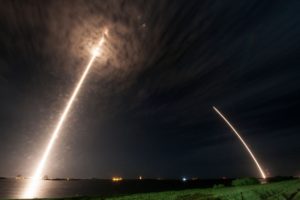
Did you know NASA’s headquarters are located in Southwest DC? Located on the corner of 4th and E St. SW, the National Aeronautics and Space Administration is in charge of U.S. science and technology that has to do with airplanes or space. The headquarters building is just one of 10 NASA centers located across the United States. What’s important to this story is the large information display screens on the front of the building. That’s where I saw a tweet from @NASASocial saying (in less than 140 characters) to apply to meet NASA Social in Cape Canaveral, Florida, to watch the next NASA and SpaceX rocket launch. I applied immediately, for journalism’s sake, mind you. (Fun fact: I studied astrophysics in undergrad and am a major space nerd.)
A time-lapse shot of the launch and landing of the Dragon 9 rocket. (Credit: SpaceX)
Did you know NASA’s headquarters are located in Southwest DC? Located on the corner of 4th and E St. SW, the National Aeronautics and Space Administration is in charge of U.S. science and technology that has to do with airplanes or space. The headquarters building is just one of 10 NASA centers located across the United States. What’s important to this story is the large information display screens on the front of the building. That’s where I saw a tweet from @NASASocial saying (in less than 140 characters) to apply to meet NASA Social in Cape Canaveral, Florida, to watch the next NASA and SpaceX rocket launch. I applied immediately, for journalism’s sake, mind you. (Fun fact: I studied astrophysics in undergrad and am a major space nerd.)
The mission was simple: Launch a rocket into space to resupply the International Space Station (ISS) with cargo, all while safely returning the rocket back to Earth by vertically landing on a launch pad for future reuse. The why is pretty simple: Save money by reusing rockets. The how, however, is not.
The Dragon 9 rides atop the Falcon 9 and is designed to deliver both cargo and, in the future, people to orbiting destinations (this time the ISS). SpaceX describes the Falcon 9 as “a two-stage rocket designed and manufactured by SpaceX for the reliable and safe transport of satellites and the Dragon spacecraft into orbit.” Falcon 9 was designed to be fully reusable and has landing legs, which are used to land the rocket safely on Earth after takeoff. Too easy, right? Not exactly. This had only been tried once before and let’s just say none of the parts or science projects aboard made it.
While I would like to say it was a childhood dream of mine to watch a launch at Cape Canaveral, I cannot. I only got into looking beyond this planet in high school and college when I was president of the space club, employee at the planetarium, and teaching assistant at the observatory—all were hidden beneath my cool guy persona on the college basketball team. (It didn’t last long.) Needless to say, this was a dream come true.
After landing in Orlando and making the one-hour commute east, I checked in for a behind-the-scenes tour with my fellow NASA Social winners. We were taken to multiple areas and even on live TV as we interviewed some of the scientists in a segment on NASA TV called “What’s on Board the SpaceX Dragon?”
Later that evening we arrived back to the media site to board the bus to go view the launch from “The Causeway” (the best public viewing location). As 12:45 a.m. struck we heard the countdown come over the live speakers, “10…9…8…” My heart raced. The engines roared. And there it was: my first launch. A beautiful yellow fire plume pushed the Falcon 9 higher and higher. The crowd cheered as the rocket pushed through the clouds and into outer space.
…But we all were waiting on Act 2: the return and landing, which, if successful, would be the first cargo mission to do so. Nearly eight minutes later a bright light appeared overhead, the Falcon 9 rocket re-entered the atmosphere and was hurtling toward us. Or so we thought. It was actually a controlled descent toward the landing pad a few miles from where the rocket launched. As it got closer to Earth you could hear the collective holdings of breath. “Come on…come on…come on,” I said. Just before touching down three loud sonic booms shook the sky. Next thing you know the landing pad glowed as speakers announced the Dragon 9 had landed! (See a
short video of my view of the landing.)
By: Shannon Vaughn
Editor-in-Chief, The Southwester



